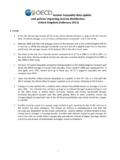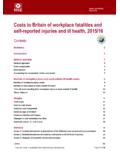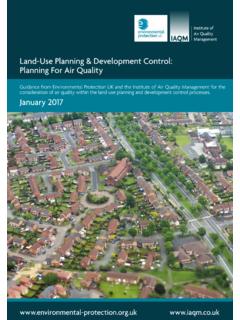Transcription of RR832 - An update of the literature on age and …
1 Health and Safety Executive An update of the literature on age and employment Prepared by the Health and Safety Laboratory for the Health and Safety Executive 2011. RR832 . Research Report Health and Safety Executive An update of the literature on age and employment Liz Yeomans Health and Safety Laboratory Harpur Hill Buxton Derbyshire SK17 9JN. Demographic trends indicate that the make up of the labour force in the UK (and other developed countries). is changing. Older workers are becoming more prevalent in the workforce, there are fewer new workers joining the labour force and older workers are continuing to retire early (Hotopp, 2005, 2007). These changes to the labour force could lead to labour and skills shortages in the future and have implications for the economy in terms of the age dependency ratio (Khan, 2009). The research in this area suggests that employers can have stereotyped views of the abilities and attitudes of older workers, which can both positively or negatively, influence the retention and recruitment of older individuals (Ilmarinen, 2006; McNair et al, 2007).
2 A previous report by Benjamin and Wilson (2005). considered some of the common stereotypes about older workers and provided evidence and arguments aimed at dispelling inaccurate perceptions about older adults. The Department for Work and Pensions (DWP) and the Health and Safety Executive (HSE) commissioned a report to review and update the Benjamin and Wilson (2005) report. The aim was to revisit the literature on age and employment which was published at the time of the Benjamin and Wilson review as well as to consider relevant literature published since (2005-2009). This updated review looks at the evidence for age-related effects on employment in the same areas addressed in the Benjamin and Wilson (2005) report. In addition the report considers trends, gender, and sector specific issues. The same definition of older worker' is used in this review as was used by Benjamin and Wilson (2005), which is workers over the age of 50. This report and the work it describes were funded by the Health and Safety Executive (HSE).
3 Its contents, including any opinions and/or conclusions expressed, are those of the author alone and do not necessarily reflect HSE policy. HSE Books Crown copyright 2011. First published 2011. You may reuse this information (not including logos) free of charge in any format or medium, under the terms of the Open Government Licence. To view the licence visit , write to the Information Policy Team, The National Archives, Kew, London TW9 4DU, or email Some images and illustrations may not be owned by the Crown so cannot be reproduced without permission of the copyright owner. Enquiries should be sent to ii CONTENTS. 1 1. 2 2. 3 GENERAL TRENDS .. 3. Trends and 3. Summary .. 9. 4 age and PRODUCTIVITY .. 10. Key 10. Relationship between age and productivity .. 10. Other aspects of performance .. 12. Other 13. Problems with 13. Summary .. 14. 5 age and ILL 15. Key 15. Health .. 15. Health and performance .. 17. Health and life 17. Ill health .. 18.
4 Psychological symptoms and mental health problems .. 20. age and MSDs .. 22. Age as risk factor for ill 23. Health and occupations .. 25. Other factors influencing health .. 27. Summary .. 27. 6 age and COGNITIVE 29. Key 29. Cognitive system .. 29. Age-resistant and declining cognitive 29. Behavoural compensation for cognitive 30. Neuroscience perspectives of age and cognition .. 30. Cognitive decline and job 31. Cognitive performance and 31. Summary .. 32. 7 AGE, PHYSICAL STRENGTH AND ENDURANCE .. 33. Key 33. Physical capacity .. 33. Cardiovascular system and 33. Physical activity .. 34. Musculoskeletal system and ageing .. 34. Recovery .. 35. iii Exercise and the training effect .. 35. Other 36. Problems with 36. Summary .. 36. 8 age and SENSORY 37. Key 37. Sensory abilities .. 37. 37. Hearing .. 38. Sensory declines with age and performance .. 38. Summary .. 38. 9 age and ADAPTATION TO CHANGE AND LEARNING .. 39. Key 39. Ability to adapt and learn.
5 39. Motivation to adapt and learn .. 40. Learning techniques .. 40. Learning and job 40. Summary .. 41. 10 age and LEVELS OF SICKNESS ABSENCE .. 42. Key 42. Definitions of sickness 42. Sickness absence trends and statistics .. 42. Findings for short and long-term 43. Other factors influencing sickness 45. Problems with 46. Summary .. 46. 11 age and ACCIDENT RATES IN THE WORKPLACE .. 47. Key 47. Trends and 47. Accidents and injury 49. Difference in types of accident and causes .. 51. Industry differences .. 52. Injury 52. New 53. Safety perceptions .. 53. Women and occupational 53. Other factors .. 54. Problems with 54. Summary .. 54. 12 WORK DESIGN AND ACCOMMODATIONS .. 56. Accommodations .. 56. Identifying the need for accommodations .. 59. Summary .. 60. iv 13 CONCLUSIONS AND 61. Conclusions .. 61. Limitations .. 62. Summary .. 63. 14 REFERENCES .. 64. 15 APPENDIX 77. Prevalence of musculoskeletal 77. Age as a risk factor for MSDs .. 77.
6 Cognition .. 78. Age-resistant cognitive 78. v vi EXECUTIVE SUMMARY Demographic trends indicate that the make up of the labour force in the UK (and other developed countries) is changing. Older workers are becoming more prevalent in the workforce, there are fewer new workers joining the labour force and older workers are continuing to retire early (Hotopp, 2005, 2007). These changes to the labour force could lead to labour and skills shortages in the future and have implications for the economy in terms of the age dependency ratio (Khan, 2009). The research in this area suggests that employers can have stereotyped views of the abilities and attitudes of older workers, which can both positively or negatively, influence the retention and recruitment of older individuals (Ilmarinen, 2006; McNair et al, 2007). A previous report by Benjamin and Wilson (2005) considered some of the common stereotypes about older workers and provided evidence and arguments aimed at dispelling inaccurate perceptions about older adults.
7 The Department for Work and Pensions (DWP) and the Health and Safety Executive (HSE) commissioned a report to review and update the Benjamin and Wilson (2005) report. The aim was to revisit the literature on age and employment which was published at the time of the Benjamin and Wilson review as well as to consider relevant literature published since (2005-2009). This updated review looks at the evidence for age-related effects on employment in the same areas addressed in the Benjamin and Wilson (2005) report. In addition the report considers trends, gender, and sector specific issues. The same definition of older worker is used in this review as was used by Benjamin and Wilson (2005), which is workers over the age of 50. Main Findings Health and life expectancy trends In the UK, there were million people 50 years or older in 2007, which is a 50% increase since 1951. This increase in older age groups is projected to continue. Similarly, the percentage of people employed in 2009 who are of Statutory Pension Age (SPA) or older has increased from 8% to 12%.
8 Life expectancy has risen between 2000 and 2005 and is projected to continue rising. It is suggested that men at 65 could now expect to live a further years in good or fairly good health and women could live for a further years. Lifestyle behaviours, such as healthy eating, smoking, alcohol consumption and levels of physical exercise, have a major impact on the health of an individual and with respect to this there is evidence that health of all age groups, including older people, is improving. Common diseases such as high blood pressure have shown a reduction in most age groups in the past few years and the proportion of people with cardiovascular diseases has remained stable. However, diabetes has shown an increase in prevalence, almost doubling in adults between 1994-2006. Obesity levels have also increased markedly since 1994 but there are indications that the trend may now be flattening out. age and productivity The conclusion of this review is that there is no consistent evidence that older workers are generally less productive than younger workers which is in agreement with the earlier Benjamin and Wilson (2005) review.
9 Most reviews and studies of work performance have not established a relationship between decreased job performance with increasing age and conclude that job performance is generally the same across all age groups. It is concluded that when abilities match job requirements and when experience is taken into account, there is little difference between the performance of older and younger workers. Where some studies into the relationship between age and productivity show mixed results, this may be because of vii differences in the nature of the job and the measure of performance used. It is suggested that performance does not necessarily decline with age because most jobs do not require employees to work at full capacity; strategies, skills and experience can be utilised to compensate for functional declines; and there is great variability in functional capabilities between individuals. Knowledge and experience have been found to compensate for age-related declines in a wide range of fields and it is suggested that practice and skills and professional expertise, developed over many years of practice and experience, can compensate for potential negative impact of declines in performance.
10 As well as there being little evidence that performance of core skills declines with age, there appears to be evidence that other aspects of performance such as good timekeeping, helping co-workers, better anger management and people skills increase with age. Some studies have also shown that older workers perform better in terms of accuracy and output consistency. age and ill health There is strong evidence that work is generally good for physical and mental health and well- being for people of all age groups and that not being in work is associated with poor physical and mental health and well-being (Waddell and Burton, 2006). There appears to be consistent evidence that ageing does generally bring an increase in the prevalence of musculoskeletal disorders (MSDs) and cardiovascular disease. However, it is important to note that a decline in health and physical capacity does not necessarily indicate an associated decline in job performance.














